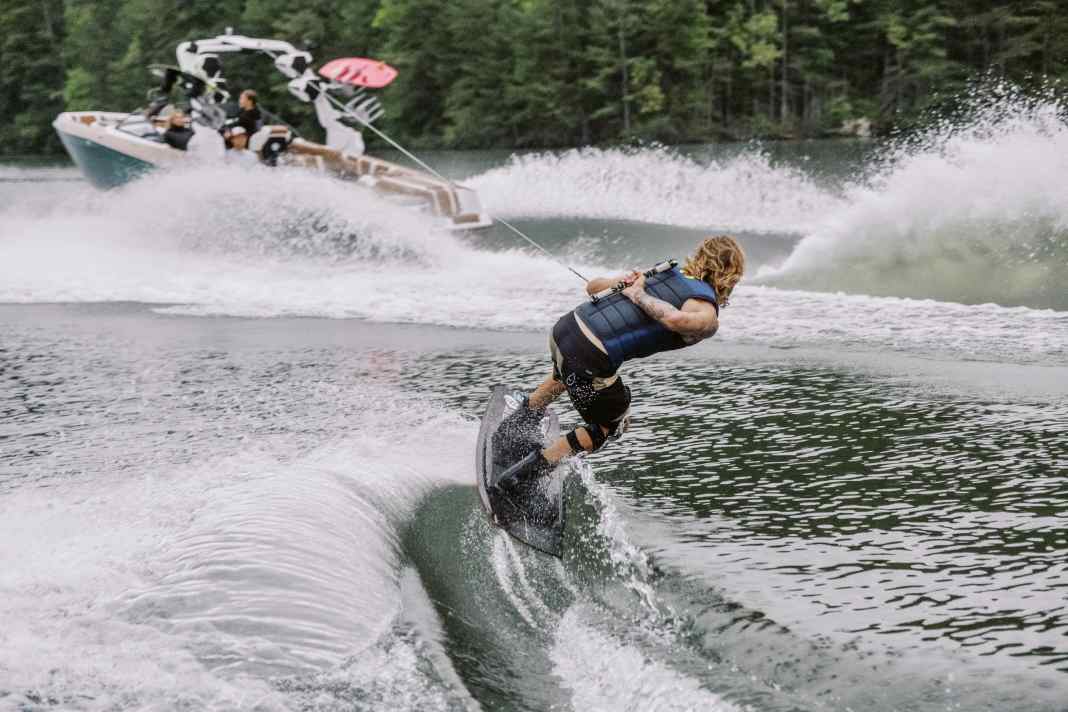





There are basically two main types of wakeboard: Boat wakeboards are designed for use behind motorboats. These boards are stiffer and, unlike the cable boards used in stationary facilities, they have fins that can either be unscrewed or are integrated into the board. The fins ensure a stable ride at higher speeds. You use the edges less and therefore put less tension on the line, which gives a more relaxed riding experience.
Cable wakeboards are used on water ski cableways. They are flexible and have rounded edges to prevent damage to obstacles. Another major difference is the so-called "grindbase". This extra layer on the underside protects the board when using obstacles.
All-round wakeboards combine the characteristics of both types and can be used in a variety of ways. They are a good compromise for beginners who want to ride both on the boat and on the track.
Wakeboard rocker shapes and their characteristics
Rocker refers to the bend of the board from the centre to the ends. It has a significant influence on the riding behaviour.
Continuous Rocker
Even bend over the entire length. Provides smooth, predictable riding characteristics and is well suited for beginners. The board feels faster, which means less edging for the rider.
3-stage rocker
Flat centre with more bend at the ends. Enables explosive jumps and aggressive turns, but requires more skill and riding technique. 3-stage boards usually feel a little slower, which means you have to go a little more on the edge yourself and put more tension on the line.
Hybrid Rocker
Continuous rocker on the edges, which enables fast riding, 3-stage rocker in the centre of the board. This variant combines relaxed riding with explosive pop.
Length and width of the wakeboard
The length of the board depends on the rider's height and weight, but above all on their "ability". Longer boards offer more buoyancy and stability, shorter boards are more manoeuvrable. However, the most important thing is the carrying capacity. Therefore, if in doubt, it is better to go one size too big than too small, as this ensures safety and takes away the fear of beginners.
The construction
Almost all modern boards have a foam core. The difference usually lies in its composition. There are special boards made from extremely light foam. However, the trick is to create a board that is still sufficiently stable. Lighter boards make jumping easier, whereas a normal board provides more stability. Beginners should start with normal boards and then gradually reduce the weight of the board.
Finns and channels
Fins provide stability and guidance in the water. Larger fins offer more control, smaller ones more freestyle possibilities. Channels are grooves in the base that provide additional support. Depending on their design, they can even replace fins in some cases.
Wakeboard bindings
The bindings connect the rider to the board. Open bindings (open toe) adapt to different shoe sizes, closed bindings (closed toe) offer better grip and more control. The bindings should fit tightly but not pinch. A little tip when trying them on: Tighten the binding, bend your knees slightly and see if the toes are still easy to move. If so, the binding will fit perfectly!
More on the topic:
Lines and handles
Leashes and handles are essential pieces of equipment for wakeboarding. The line is available in PU or Dyneema. PU is the cheapest option. It stretches, which is particularly annoying when jumping. Professionals speak disdainfully of "bungee lines". Dyneema, on the other hand, has little to no stretch. Direct pull when edging, jumping and landing. This line therefore also has many advantages for beginners. Handles are available in all variations. The important thing here is that the grip is good and the diameter is not too large. Large diameters are usually a little more difficult to hold and require more strength. A little tip: handles in bright, bright colours are easier to spot in the water.
Wakeboards for beginners vs. advanced riders: Our purchase recommendations
Beginners should opt for an all-round board with continuous rocker. Advanced riders can choose a specialised boat or cable board depending on their preferences. And one more tip: buying in a shop is always more advisable for beginners than a hasty quick purchase on the internet.

